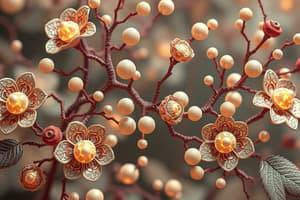Podcast
Questions and Answers
What is the primary reason for the increased potency of enalaprilat compared to captopril?
What is the primary reason for the increased potency of enalaprilat compared to captopril?
- Faster metabolism
- Lower side effects
- Higher dosage required
- Enhanced binding capability (correct)
How does the methyl group replacement for histidine in enalaprilat impact its affinity?
How does the methyl group replacement for histidine in enalaprilat impact its affinity?
- Enhances desolvation effects
- Decreases lipophilicity
- Increases hydrophilicity
- Reduces desolvation effects (correct)
What effect does the substitution of leucine with a pyrrolidine group have on ligand flexibility?
What effect does the substitution of leucine with a pyrrolidine group have on ligand flexibility?
- Keeps flexibility unchanged
- Increases hydrophobicity
- Increases flexibility
- Decreases flexibility (correct)
What characteristic of histidine negatively affects drug affinity in enalaprilat?
What characteristic of histidine negatively affects drug affinity in enalaprilat?
What is the significance of mimicry of the transition state in the binding of enalaprilat?
What is the significance of mimicry of the transition state in the binding of enalaprilat?
Which change contributes to higher overall affinity of enalaprilat compared to angiotensin I?
Which change contributes to higher overall affinity of enalaprilat compared to angiotensin I?
Why is the imidazole ring of histidine considered disadvantageous for affinity in enalaprilat?
Why is the imidazole ring of histidine considered disadvantageous for affinity in enalaprilat?
How does the overall design of enalaprilat improve its interaction with the angiotensin converting enzyme (ACE)?
How does the overall design of enalaprilat improve its interaction with the angiotensin converting enzyme (ACE)?
What structural feature of lisinopril allows it to potentially pass through the lipid bilayer despite being highly hydrophilic?
What structural feature of lisinopril allows it to potentially pass through the lipid bilayer despite being highly hydrophilic?
In the structural-activity relationship of angiotensin receptor blockers, which R group should be replaced to enhance activity?
In the structural-activity relationship of angiotensin receptor blockers, which R group should be replaced to enhance activity?
Why is the tetrazole ring preferred as a bioisostere for the carboxylic acid functional group?
Why is the tetrazole ring preferred as a bioisostere for the carboxylic acid functional group?
What is the active metabolite of Losartan and its significance?
What is the active metabolite of Losartan and its significance?
Which compound is identified as the active agent based on the structure-activity relationship of calcium channel blockers?
Which compound is identified as the active agent based on the structure-activity relationship of calcium channel blockers?
What is the underlying condition characterized by elevated levels of lipids in the blood?
What is the underlying condition characterized by elevated levels of lipids in the blood?
Which lipoprotein has the highest percentage of protein?
Which lipoprotein has the highest percentage of protein?
What strategies can be employed to counteract the effects of Angiotensin II?
What strategies can be employed to counteract the effects of Angiotensin II?
What is the primary role of HMG–CoA reductase in cholesterol biosynthesis?
What is the primary role of HMG–CoA reductase in cholesterol biosynthesis?
Which of the following drugs is an example of an HMG-COA reductase inhibitor?
Which of the following drugs is an example of an HMG-COA reductase inhibitor?
Which mechanism describes how angiotensin II causes rapid hypertension?
Which mechanism describes how angiotensin II causes rapid hypertension?
What structural components of Enalaprilat are responsible for its high hydrophilicity?
What structural components of Enalaprilat are responsible for its high hydrophilicity?
What are the three classifications of ACE inhibitors based on their chemical composition?
What are the three classifications of ACE inhibitors based on their chemical composition?
In the stomach at pH 1.5, what charges do the acidic functional groups of Enalaprilat carry?
In the stomach at pH 1.5, what charges do the acidic functional groups of Enalaprilat carry?
Why is Pravastatin considered more hydrophilic than lovastatin or simvastatin?
Why is Pravastatin considered more hydrophilic than lovastatin or simvastatin?
How does esterification of Enalaprilat affect its lipophilicity?
How does esterification of Enalaprilat affect its lipophilicity?
What effect do bile acid sequestrants have on cholesterol absorption?
What effect do bile acid sequestrants have on cholesterol absorption?
What common side effects are associated with the sulfhydryl group of captopril?
What common side effects are associated with the sulfhydryl group of captopril?
How does enalaprilat's potency compare to captopril?
How does enalaprilat's potency compare to captopril?
What factors affect the activity of HMG-COA reductase inhibitors?
What factors affect the activity of HMG-COA reductase inhibitors?
What charge does the secondary amine of Enalaprilat carry in the small intestine at pH 7?
What charge does the secondary amine of Enalaprilat carry in the small intestine at pH 7?
What modification to a compound leads to the drug Ezetimibe?
What modification to a compound leads to the drug Ezetimibe?
What is one long-term effect of angiotensin II's stimulation of the adrenal gland?
What is one long-term effect of angiotensin II's stimulation of the adrenal gland?
Why is it beneficial for Enalaprilat to form a zwitterion in a neutral pH environment?
Why is it beneficial for Enalaprilat to form a zwitterion in a neutral pH environment?
How does the pKa value of the secondary amine change after esterification?
How does the pKa value of the secondary amine change after esterification?
What contributes to captopril's shorter half-life?
What contributes to captopril's shorter half-life?
What characteristic of pravastatin contributes to a reduction in side effects compared to simvastatin?
What characteristic of pravastatin contributes to a reduction in side effects compared to simvastatin?
Which of the following mechanisms does NOT increase blood pressure as a result of high levels of angiotensin II?
Which of the following mechanisms does NOT increase blood pressure as a result of high levels of angiotensin II?
What is the overall charge of Enalaprilat at a neutral pH of 7?
What is the overall charge of Enalaprilat at a neutral pH of 7?
What effect does the presence of two carboxylate groups have on Enalaprilat's oral bioavailability?
What effect does the presence of two carboxylate groups have on Enalaprilat's oral bioavailability?
Why does IV-administered enalapril produce similar effects on angiotensin II production as enalaprilat despite its lower in vitro activity?
Why does IV-administered enalapril produce similar effects on angiotensin II production as enalaprilat despite its lower in vitro activity?
Which functional groups are essential for optimal binding with Zn$^{2+}$ in the angiotensin-converting enzyme (ACE)?
Which functional groups are essential for optimal binding with Zn$^{2+}$ in the angiotensin-converting enzyme (ACE)?
Which compound is considered inactive as an angiotensin-converting enzyme inhibitor?
Which compound is considered inactive as an angiotensin-converting enzyme inhibitor?
What is the role of hydrophobic substituents in the structural-activity relationship of ACE inhibitors?
What is the role of hydrophobic substituents in the structural-activity relationship of ACE inhibitors?
How does the charge state of lisinopril contribute to its oral activity?
How does the charge state of lisinopril contribute to its oral activity?
What distinguishes the activity levels of enalapril and enalaprilat?
What distinguishes the activity levels of enalapril and enalaprilat?
What factor most strongly correlates with the potency of angiotensin-converting enzyme inhibitors?
What factor most strongly correlates with the potency of angiotensin-converting enzyme inhibitors?
Which statement is correct regarding the conversion of enalapril to enalaprilat?
Which statement is correct regarding the conversion of enalapril to enalaprilat?
Flashcards
Why is enalaprilat more potent than captopril?
Why is enalaprilat more potent than captopril?
Enalaprilat's ability to bind to ACE more effectively than captopril is because it better mimics the transition state of angiotensin I hydrolysis. This leads to stronger interactions with the enzyme and increased potency.
How does the replacement of histidine with a methyl group in enalaprilat affect affinity?
How does the replacement of histidine with a methyl group in enalaprilat affect affinity?
Replacing the imidazole ring of Histidine in angiotensin I with a methyl group in enalaprilat reduces desolvation effects, increasing affinity. The imidazole ring, being hydrophilic, causes desolvation without valuable interactions. Replacing it with a lipophilic methyl group reduces desolvation and improves ligand-protein recognition.
How does the replacement of leucine with a pyrrolidine group in enalaprilat affect affinity?
How does the replacement of leucine with a pyrrolidine group in enalaprilat affect affinity?
Replacing the isobutyl chain of Leucine in angiotensin I with a pyrrolidine ring in enalaprilat makes the ligand more rigid. This rigidity improves ligand recognition and enhances the affinity of enalaprilat compared to the natural substrate.
How do strategies counteract Angiotensin II effects?
How do strategies counteract Angiotensin II effects?
Signup and view all the flashcards
How does Angiotensin II contribute to hypertension?
How does Angiotensin II contribute to hypertension?
Signup and view all the flashcards
How are ACE inhibitors classified?
How are ACE inhibitors classified?
Signup and view all the flashcards
What are the side effects associated with captopril's sulfhydryl group?
What are the side effects associated with captopril's sulfhydryl group?
Signup and view all the flashcards
How does enalaprilat's potency differ from captopril?
How does enalaprilat's potency differ from captopril?
Signup and view all the flashcards
How can lisinopril pass through the lipid bilayer?
How can lisinopril pass through the lipid bilayer?
Signup and view all the flashcards
Which R group in ARBs should be replaced with a tetrazole for enhanced activity?
Which R group in ARBs should be replaced with a tetrazole for enhanced activity?
Signup and view all the flashcards
Why is tetrazole an optimal bioisostere for the carboxylic acid group?
Why is tetrazole an optimal bioisostere for the carboxylic acid group?
Signup and view all the flashcards
What is the active metabolite of Losartan?
What is the active metabolite of Losartan?
Signup and view all the flashcards
Which compound is the active agent based on SAR of calcium channel blockers?
Which compound is the active agent based on SAR of calcium channel blockers?
Signup and view all the flashcards
Why is enalapril's in vitro activity much lower than enalaprilat's, but in vivo effects are similar?
Why is enalapril's in vitro activity much lower than enalaprilat's, but in vivo effects are similar?
Signup and view all the flashcards
Which groups bind well to the zinc ion in ACE?
Which groups bind well to the zinc ion in ACE?
Signup and view all the flashcards
What structural feature is essential for ACE inhibitor activity?
What structural feature is essential for ACE inhibitor activity?
Signup and view all the flashcards
Which of these ACE inhibitors is the most potent, and why?
Which of these ACE inhibitors is the most potent, and why?
Signup and view all the flashcards
How can lisinopril, a highly hydrophilic drug, be orally active?
How can lisinopril, a highly hydrophilic drug, be orally active?
Signup and view all the flashcards
What makes Enalaprilat hydrophilic?
What makes Enalaprilat hydrophilic?
Signup and view all the flashcards
How does Enalaprilat's hydrophilicity affect its bioavailability?
How does Enalaprilat's hydrophilicity affect its bioavailability?
Signup and view all the flashcards
What is Enalaprilat's charge in the stomach?
What is Enalaprilat's charge in the stomach?
Signup and view all the flashcards
What is Enalaprilat's charge in the small intestine?
What is Enalaprilat's charge in the small intestine?
Signup and view all the flashcards
How does esterification increase Enalaprilat's lipophilicity?
How does esterification increase Enalaprilat's lipophilicity?
Signup and view all the flashcards
How does esterification affect Enalaprilat's charge in the intestine?
How does esterification affect Enalaprilat's charge in the intestine?
Signup and view all the flashcards
Why is only one carboxylic acid esterified?
Why is only one carboxylic acid esterified?
Signup and view all the flashcards
How does the zwitterion form improve bioavailability?
How does the zwitterion form improve bioavailability?
Signup and view all the flashcards
Hyperlipidemia
Hyperlipidemia
Signup and view all the flashcards
How are lipoproteins classified?
How are lipoproteins classified?
Signup and view all the flashcards
What's the primary enzyme in cholesterol synthesis?
What's the primary enzyme in cholesterol synthesis?
Signup and view all the flashcards
Bile acid sequestrants
Bile acid sequestrants
Signup and view all the flashcards
Give three examples of HMG-CoA reductase inhibitors.
Give three examples of HMG-CoA reductase inhibitors.
Signup and view all the flashcards
What affects the activity of HMG-CoA reductase inhibitors?
What affects the activity of HMG-CoA reductase inhibitors?
Signup and view all the flashcards
Why is Pravastatin more hydrophilic than other statins?
Why is Pravastatin more hydrophilic than other statins?
Signup and view all the flashcards
What are the modifications in Ezetimib?
What are the modifications in Ezetimib?
Signup and view all the flashcards
Study Notes
Strategies to Counteract Angiotensin II
- Strategies to reduce Angiotensin II effects involve inhibiting enzymes like ACE, blocking receptors, or impeding renin activity.
- These methods disrupt different points in the renin-angiotensin pathway to lessen Angiotensin II's influence on blood pressure regulation.
Angiotensin II and Hypertension
- Angiotensin II rapidly constricts blood vessels, increasing blood pressure.
- Slowly, it stimulates the adrenal glands to release aldosterone, promoting water and electrolyte retention, increasing blood volume and sustained hypertension.
ACE Inhibitors Classification
- ACE inhibitors are categorized chemically into three groups:
- Sulfhydryl-containing (e.g., captopril)
- Dicarboxylate-containing (e.g., enalapril)
- Phosphonate-containing (e.g., fosinopril)
Captopril Side Effects
- Captopril's sulfhydryl group contributes to both its strong inhibitory activity and common side effects.
- These side effects include skin rashes and taste disturbances (metallic taste or loss of taste).
Enalaprilat Potency
- Enalaprilat is approximately 10 times more potent than captopril, due to potentially enhanced binding effects mimicking the transition state, leading to more specific interactions with the target enzyme.
Angiotensin I and Enalaprilat Affinity
- Replacing histidine with a methyl group in angiotensin I enhances enalaprilat's affinity over the natural substrate.
- The imidazole ring in histidine is hydrophilic, reducing affinity. Replacing it with a lipophilic methyl improves ligand recognition and affinity.
Enalaprilat Hydrophilicity/Lipophilicity
- Enalaprilat's structural components (carboxylates and secondary amine group) make it less lipophilic, leading to reduced oral bioavailability.
Enalaprilat Charges in different pH
- In acidic stomach (pH 1.5), carboxylic acids remain non-ionized, and amine group is positively charged.
- In alkaline small intestine (pH 7), carboxylic acids and amine group are ionized, resulting in a zwitterion.
Enalaprilat Esterification and Bioavailability
- Esterifying one carboxylic acid in enalaprilat enhances lipophilicity, possibly improving bioavailability.
- The zwitterion form in neutral pH improves gastrointestinal absorption.
Enalapril and Enalaprilat Action
- Enalapril is a prodrug; in the body it converts into Enalaprilat, its active form.
- In vitro, enalapril shows significantly lower activity compared to enalaprilat but similar in vivo effects due to rapid conversion to the active form.
ACE Inhibition by Functional Groups
- Functional groups like phosphinic acid, sulfhydryl, and carboxylate groups play key roles in optimal binding with Zn²⁺ in the ACE active site.
Inactive ACE Inhibitor
- Among provided structures, a compound lacking the ring carboxylic acid is not considered an active agent because it doesn't mimic the C-terminal carboxylate of the ACE substrates.
Potent ACE Inhibitors
- Structures with hydrophobic substituents on their pyrrolidine ring are more potent based on molecular interaction capabilities.
Lisinopril Hydrophilicity and Oral Activity
- Lisinopril, despite being highly hydrophilic, is orally active. This is possibly due to its internal binding and neutral net charge, facilitating passage through the lipid bilayer.
Replacement of R-groups in ARBs
- In the ARB structural activity relationship, replacing the R1 group with a tetrazole group enhances activity.
Tetrazole and Bioavailability
- Tetrazole is used as a bioisostere for carboxylic acids in some cases, which contributes to enhanced bioavailability by possessing similar electronic and steric properties.
Losartan Active Metabolite
- Losartan's active metabolite, EXP-3174, is formed by oxidation of the hydroxy methyl group into carboxylic acid by CYP2C9 and CYP3A4 enzymes.
SAR of Calcium Channel Blockers
- Structurally, a dihydropyridine ring (in compound b) is crucial for activity in calcium channel blockers. Substitutions in other areas greatly diminish or eliminate activity.
Hyperlipidemia Definition
- Hyperlipidemia is characterized by elevated levels of cholesterol, cholesterol esters, triglycerides, and phospholipids in the blood.
Lipoprotein Classification
- Lipoproteins are classified based on their density: Very Low Density Lipoproteins (VLDLs), Intermediate Density Lipoproteins (IDLs), Low Density Lipoproteins (LDLs), and High Density Lipoproteins (HDLs). These differ in protein content.
Studying That Suits You
Use AI to generate personalized quizzes and flashcards to suit your learning preferences.




